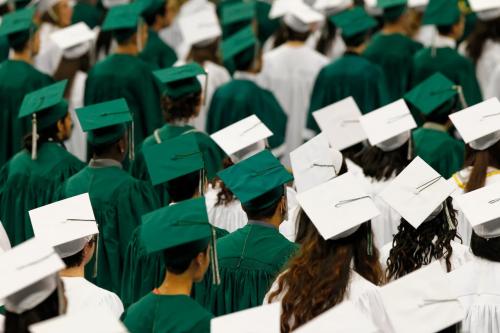Standardized tests perpetuate inequality in college admissions, but what about other parts of college applications? Extracurricular activities have the veneer of leveling the playing field—in theory, anyone can join a club or sign up for activities. However, activities like music lessons and sports cost money, as well as time and resources for students and their families. Extracurricular involvement is generally less accessible to students who have to work to support their families, and some activities still reflect the impact of historic exclusion (e.g., swimming for Black youth).
Why does this matter? Certain activities like athletics are especially valued in admissions for elite institutions. As documented in the Students for Fair Admissions v. Harvard trial, Harvard dedicated two ratings to extracurricular activities, an extracurricular rating and an athletic rating, and even being a non-recruited athlete was linked with a higher likelihood of admission. Previous work has also found that students who listed more activities were more likely to be admitted to a selective institution.
Using big data and natural language processing to examine self-reported extracurricular activities
For years, detailed research on extracurricular activities was hindered by the lack of tools that could analyze hundreds of thousands of text-centric applications at scale, as well as a lack of access to system-wide applicant data. However, with developments in natural language processing techniques, researchers can analyze large bodies of non-standardized text at unprecedented scope and scale, opening the door for new research. We combined these new tools with newly unified data on applications and applicants from The Common Application (“Common App”), the country’s largest postsecondary application platform.
In a recent working paper, our team analyzed inequality related to race and socioeconomic status (SES) in extracurricular reporting in college applications. We used human-crafted keyword dictionaries in combination with more advanced natural language processing techniques to analyze about 6 million applications filed by 860,003 applicants. We focus on those who applied to at least one selective (admit rate of 40% or lower) institution during the 2018-2019 or 2019-2020 cycles.
Beyond categorizing and counting activities, we wanted to understand some of the nuances behind how students described their involvement—a unique contribution to research on extracurricular activities. We developed two constructs of interest: “top-level leadership” (i.e., whether an applicant reported a position or title reflecting the highest level of leadership or responsibility for an activity, e.g., captain, president, CEO) and “excellence” (i.e., whether an applicant reported an award, honor, or distinction indicating a noteworthy level of skill or accomplishment, e.g., MVP, champion, all-state).
Large differences in extracurricular activities by race, income
We find that—on average—white, Asian American, higher-SES, and private school students listed more activities, top-level leadership positions, and excellence distinctions. While Black, Latino, Indigenous, and low-income students listed fewer activities, leadership positions, and awards/honors, they reported top leadership positions at a rate similar to their peers from other groups. In other words, the proportion of activities where a student listed a top-level leadership position was extremely similar, if not identical, between groups. For example, both white and Black students held a top leadership role for 14% of their total activities. Similar dynamics exist related to honors/awards, where examining proportions of activities with honors/awards results in fewer equity gaps than just comparing absolute numbers.
Disparities related to the raw number of activities, leadership positions, and honors reported by applicants are related to a combination of factors that often facilitate participation for historically privileged groups and deter it for others. Research documents how lower-SES and many racially minoritized students face barriers to participating in a wider range of extracurricular activities. Certain opportunities are more common within private or affluent public suburban schools, such as the ability to participate in certain middle school activities (e.g., Science Olympiad and debate), helping students gain a competitive edge in high school. The same goes for more specialized sports like lacrosse, rowing, and fencing, where financial costs and availability constrain access. In fact, we found some of the largest disparities in athletics, consistent with past research. Applicants from private schools reported about 36% more athletic activities than public school peers, and white students were more likely than students of color to report top-level leadership roles and honors/awards in athletics.
As noted, certain activities are affected by a legacy of historical exclusion. This exclusion, whether intentional or not, is often combined with community-based socialization that influences how certain activities become dominated by certain groups. For example, the competitive spelling bee circuit is frequented by many South Asian American students, and classical music is dominated by East Asian Americans and white students.
Disparities may also be driven by socialization that white, Asian American, and higher-SES students experience, where “résumé packing” is a common behavior within peer groups. Bourdieu’s concept of habitus describes how social class and other contexts influence people’s expectations for what is considered normal, and in many high schools, piling on extracurricular activities is often seen as the norm. Concurrently, many students are responding to a sense of increased competition in college admissions—listing more extracurricular accomplishments in hopes of distinguishing themselves in a packed field.
Notably, some of our analyses compared students from the same high school or compared students from the same high school who have similarly high test scores (i.e., 95th percentile or higher). This helps us see where disparities arise. In some cases, we observed disparities getting smaller as our comparison window tightened. For example, Black students still reported fewer top-level leadership roles than white students at the same high school, but no significant difference remained when we further restricted to students with high test scores. However, even when comparing students with similarly high test scores from the same high schools, first-generation applicants reported significantly fewer top-level leadership roles, while students from the highest quintile of household income reported significantly more. This shows that disparities do exist within schools, even among students with similar academic performance.
So, what should we do about extracurriculars in college admissions?
Our research indicates that extracurricular involvement is not a level playing field, both in the number of activities that students report and associated leadership positions, honors, and awards. We do not think our findings support eliminating the extracurricular portion of the application, nor do they suggest that institutions should move back to requiring standardized tests, which are beset with their own equity issues. However, findings provide key insights needed to strengthen holistic review as institutions grapple with how to expand opportunity and access.
We make two main recommendations. First, admissions officers need to be regularly trained in how racial and economic inequality manifests in non-standardized components of applications. Studies suggest that admissions officers experience challenges in fully considering how inequality influences educational opportunity and life circumstances, and training around inequality for admissions officers is troublingly rare. In light of the role that extracurricular activities play in holistic review, especially at more selective institutions, helping application readers understand the conditions affecting extracurricular participation (and other non-standardized components of applications, e.g., essays) is critical.
Second, we suggest that institutions and college application platforms consider reducing the number of activities that students are asked to list on applications. As noted, we find larger disparities in the total number of activities that students report than in the share of their activities for which they report leadership roles. Currently, most applications allow students to list 8-10 activities. Lowering the number of activities that applicants can report might reduce rewarding certain students for simply listing more activities. Inequities will still persist, but some disparities will likely lessen. As an added benefit, students might find themselves able to focus on the quality of their extracurricular participation, not the quantity.
Stepping back, our work continues the conversation on how inequality is prevalent within non-standardized components of the college application. While extracurricular activities have a role to play in helping institutions understand applicants, this research highlights the nuance and complexity involved.
The Brookings Institution is committed to quality, independence, and impact.
We are supported by a diverse array of funders. In line with our values and policies, each Brookings publication represents the sole views of its author(s).












